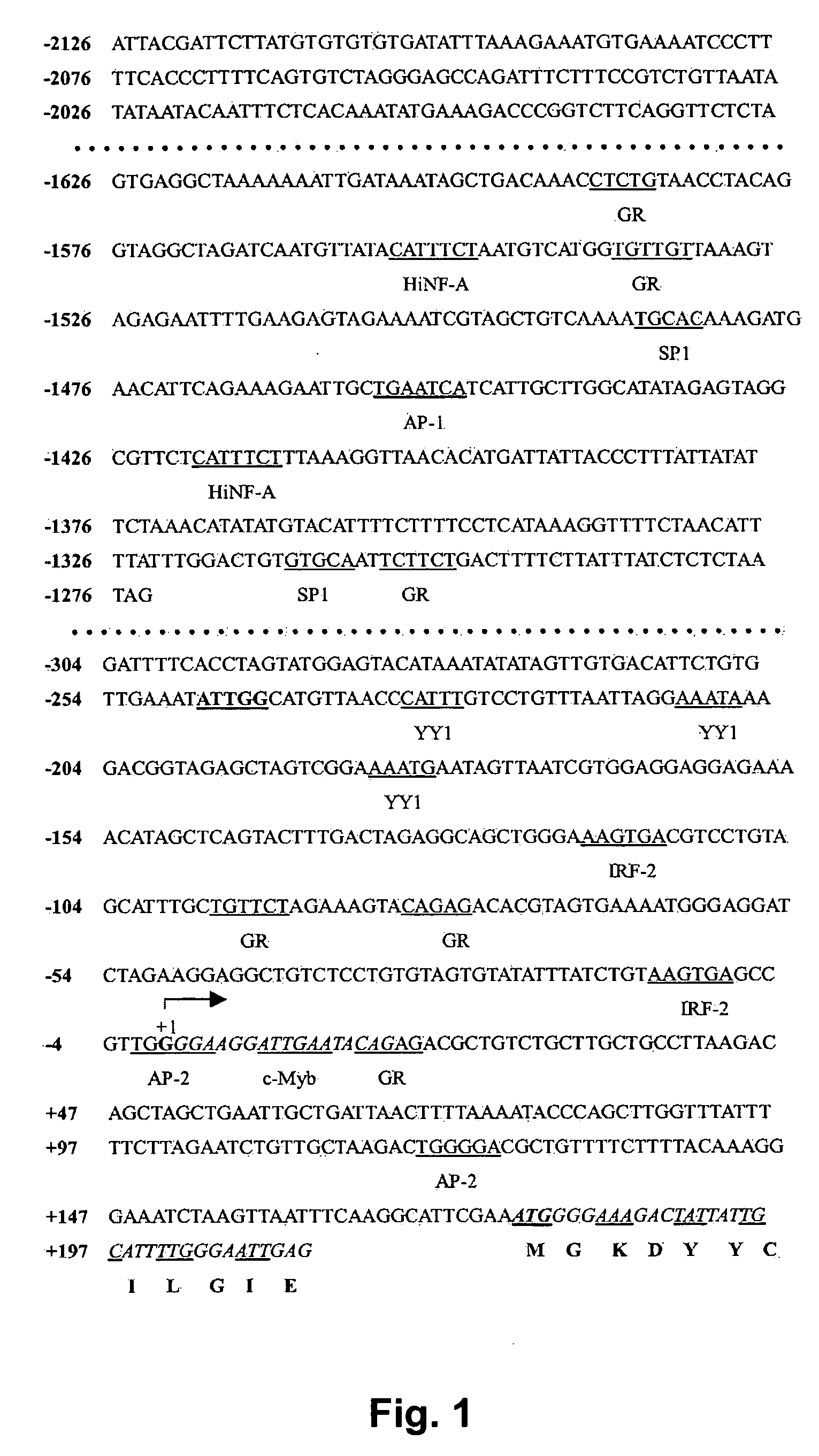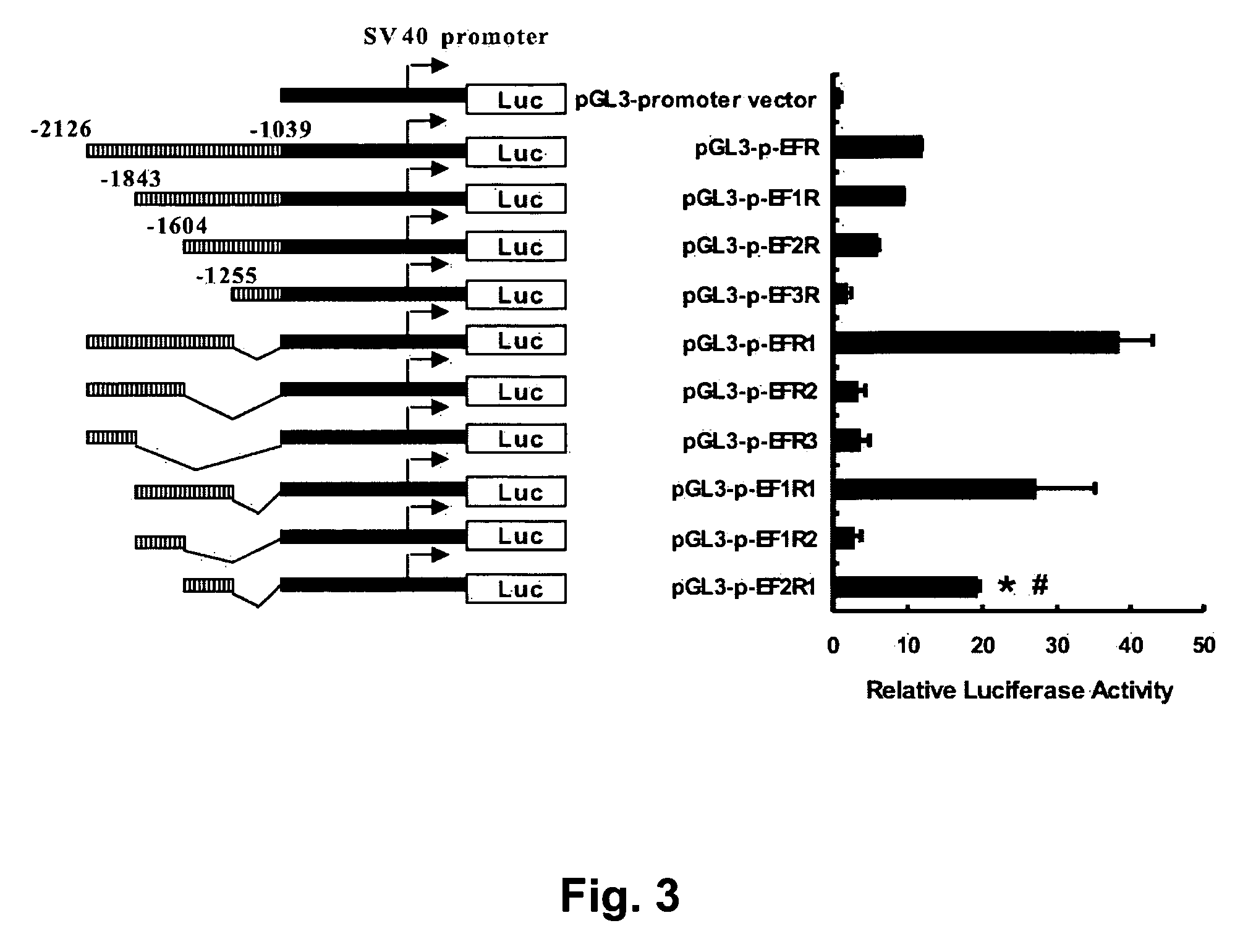HLJ1 gene expression
a technology of hlj1 and promoter activity, which is applied in the direction of immunoglobulins, peptides, drugs, etc., can solve the problem of less than 15% of the overall five-year survival rate of lung cancer, and achieve the effect of increasing the promoter activity of hlj1 and increasing hlj1 expression
- Summary
- Abstract
- Description
- Claims
- Application Information
AI Technical Summary
Benefits of technology
Problems solved by technology
Method used
Image
Examples
example 1
Cloning and Analysis of the Human HLJ1 5′ Flanking Region
[0164] A PCR based method was used to clone the 5′ flanking region of the human HLJ1 gene. Specific primers were designed from the 5′-end of the known HLJ1 cDNA sequence (7) and from GenBank. CL1-0 cell genomic DNA was isolated by QIAamp DNA blood mini kit (Qiagen) and served as the PCR template. The sequences of the primers in the primer set used in the PCR amplification are: HLJP-F primer, 5′-CCGCTCGAGATTACGATTCTTATGTGTG TG-3′ (SEQ. ID. NO.:37), which introduced an XhoI site (underlined); and HLJP-R1 primer, 5′-CCCAAGCTTCTCAATTCCCAAAAT GCAAT AATAG-3′ (SEQ. ID. NO.:38), which introduced a HindIII site (underlined). The PCR conditions were as follows: one cycle for 2 min 30 sec at 94° C., 1 min at 55° C., 3 min at 72° C.; followed by 34 cycles for 40 sec at 94° C., 1 min at 60° C., 3 min at 72° C.; and final extension at 72° C. for 10 min. The amplified DNA fragment consisted of 2,338 bp; it was digested with XhoI / HindIII and...
example 2
5′-Rapid Amplification of cDNA Ends (RACE)
[0167] Transcription start sites were identified by 5′-rapid amplification of cDNA ends using the 5′-RACE method as previously described (17). Briefly, 10 μg total RNA isolated from CL1-0 cells was reverse transcribed by Superscript RT II (Gibco Life Technologies (Invitrogen Life Technologies), Carlsbad, Calif.) using the T20 primer (5′-TTTTTTTTTTTTTTTTTTTT-3′) and the CapSwitch primer (5′-AAGCAGTGGTATCAA CGCAGAGTACGCrGrGrG-3′). The reverse transcription PCR was first performed on a DNA cycler at 42° C. for 1 hour and 94° C. for 5 minutes. One μl of the first-stranded cDNA was added to 50 μl PCR mixture with TSP primer (5′-GCAGTGGTATC AACGCAGAG-3′) and QHLJ1-R primer (5′-CCATCCAGTGTTGGTACATTAATT-3′) (SEQ. ID. NO.:39). The PCR conditions were one cycle for 2 min 30 sec at 94° C., 1 min at 55° C. and 3 min at 72° C.; followed by 34 cycles for 40 sec at 94° C., 1 min at 60° C., and 3 min at 72° C.; then a final extension step at 72° C. for 10 ...
example 3
Construction of Luciferase Reporter Gene Constructs
[0168] Promoter constructs corresponding to varying lengths of the 5′ flanking region of the HLJ1 gene were generated by PCR using the pGL3-HLJP construct as the template. A common reverse primer (HLJP-RER) (SEQ. ID. NO.:22) and different forward primers (HLJP-F1, HLJP-F2, HLJP-F3, HLJP-F4, HLJP-F5, HLJP-F6, and HLJP-REF) (SEQ. ID. NO.:15-21), shown in Table 1, were used to amplify various deletion fragments, producing the promoter constructs. XhoI and HincII sites were introduced into the forward and reverse primers, respectively, and used to clone these fragments upstream of a luciferase reporter gene in the promoterless vector pGL3-basic (Promega, Madison Wis.). The pGL3-Control plasmid was used as a positive control, and was also obtained from Promega (Madison Wis.).
[0169] A similar approach was used to make the HLJ1 enhancer constructs, which were also generated by PCR and ligated into the MluI / XhoI sites of the enhancerless ...
PUM
| Property | Measurement | Unit |
|---|---|---|
| nucleic acid | aaaaa | aaaaa |
| molecular weights | aaaaa | aaaaa |
| environmental stress | aaaaa | aaaaa |
Abstract
Description
Claims
Application Information
 Login to View More
Login to View More - R&D
- Intellectual Property
- Life Sciences
- Materials
- Tech Scout
- Unparalleled Data Quality
- Higher Quality Content
- 60% Fewer Hallucinations
Browse by: Latest US Patents, China's latest patents, Technical Efficacy Thesaurus, Application Domain, Technology Topic, Popular Technical Reports.
© 2025 PatSnap. All rights reserved.Legal|Privacy policy|Modern Slavery Act Transparency Statement|Sitemap|About US| Contact US: help@patsnap.com



